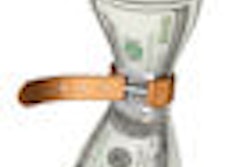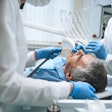
While the recently negotiated American Taxpayer Relief Act of 2012 (ATRA) will increase taxes for many dentists, the cloud does have a silver lining for those able to take advantage of the increase in deductions for new equipment and the extension of other tax breaks.
 J. Haden Werhan, CPA.
J. Haden Werhan, CPA.
Among the most significant deductions is the increase in the maximum that can be expensed for new equipment under Section 179, according to J. Haden Werhan, a certified public accountant (CPA) with Thomas Wirig Doll, an accounting and wealth management firm that works with dentists. Prior to the ATRA, the maximum amount that could be deducted under Section 179 was $139,000 in 2012, which was scheduled to go down to $25,000 in 2013. However, retroactively effective for 2012 and 2013, the ATRA increases the maximum amount that can be expensed to $500,000.
"It's simply a matter of stimulating the economy and getting people to make equipment purchases," Werhan said. Dental equipment is expensive, and a big purchase for a dentist would be a CT scanner or CAD/CAM system, he added.
"I think it's a relief that's it's been extended," Werhan said. "People will have some breathing room to make purchases, but one of the realities of big purchases for dentists is they're often financed. So when you pay back the loan, you deduct the interest, but you have to pay back the principal, which is done with after-tax dollars. If you take a big write-off the first year, you don't have any left for future years when your taxable income is higher and your actual cash flow is lower. You can save money under Section 179, but if you don't plan ahead, you'll have huge cash flow problems later."
Leasehold improvements
For dentists building new offices, the ATRA also extends for two years the provision that up to $250,000 of qualified leasehold improvements are eligible for expensing or for a 15-year depreciation, Werhan noted. The definition of qualified leasehold improvements is complicated, but for dentists who lease their offices and make new leasehold improvements, the expenses will qualify. The 15-year limit had been temporary -- previously it was 39 years -- but it was extended to cover 2012 and 2013, Werhan added.
"That's huge, because if you build an office and borrow money to do it, you have to pay back the loan, usually in seven to 10 years. But a write-off over 39 years helps you offset the cash flow problem with borrowing money," he said.
If a dentist owns his or her office, those same leasehold improvements do not qualify and must be depreciated over 39 years. "This makes a cost segregation study all that much more important for dentists who practice in real property that they own," Werhan said. "You have to maintain your practice and keep it modern, viable, and up-to-date technologically. But you have to plan those expenses; you don't go out and do it just because there's a tax break."
Dentists must also have new equipment installed, working, and in use for patient care before the expense can be deducted. For instance, if a dentist got an $80,000 loan for a computer system and digital radiography in October 2012 but the new systems didn't "go live" until January 2013, the cost cannot be deducted on the 2012 tax return. However, if there are enough write-offs for 2012, the purchase of the new technology would later be an advantage if the dentist's earnings subsequently bumped him or her into the highest tax bracket.
This strategy still made sense despite the fact that a technology purchase in 2012 will be subject to the 2.3% medical device excise tax under the Patient Protection and Affordable Care Act (ACA). The technology purchase would be written off at $16,000 per year for five years while paying off the loan. The medical device tax will be collected like a sales tax from vendors.
Section 179 limitations; bonus depreciation
Section 179 may be used to bring a dentist's income to zero, Werhan noted. Any amount that is not allowed as a deduction because of this limitation may be carried forward to succeeding tax years. Any amount not elected as a Section 179 deduction may be written off (depreciated) over the appropriate lifetime for the asset. In other words, it is not a "use it or lose it" proposition.
“You can save money under Section 179, but if you don't plan ahead, you'll have huge cash flow problems later.”
Also, many states do not comply with the federal rules for Section 179, so dentists in those states will have higher taxable state income than taxable federal income. Thus, whether to use Section 179 and how much to use in any given year should be carefully considered by dentists and their dental CPAs, according to Werhan.
Before the ATRA, bonus depreciation was set to expire at the end of 2012. Bonus depreciation allows 50% of the adjusted basis (cost) of qualified property to be depreciated in the year it is placed into service. Now, however, the 50% first-year bonus depreciaÂtion has been extended so that it applies to qualified property acquired and placed in service before January 1, 2014. It also extends the $8,000 boost in the first-year depreciation cap for light trucks and automobiles until the end of 2013, Werhan said.
How to handle higher taxes
Dentists and others with higher incomes (more than $250,000 for joint incomes and more than $200,000 for singles) will face higher federal taxes, including 0.9% for the high-income Hospital Insurance tax and 3.8% for the Medicare investment tax.
In California, Proposition 30 also will raise taxes 1% on higher incomes, retroactive to 2012. For joint incomes more than $500,000, the state income tax will go from 9.3% to 10.3%; for incomes more than $600,000, tax rates will rise from 10.3% to 11.3%; for incomes more than $1 million, the rate will go from 11.3% to 12.3%. The thresholds for single dentists are half the amounts for joint tax return filers.
The increases in federal and state taxes could push total taxes past 50% for high-income earners, Werhan noted.
However, there are a number of ways to offset the new higher taxes, Werhan noted, including employing family members in your practice, setting up a defined benefit pension plan, or forming an S corporation.
Having your spouse work in the practice allows an additional 401(k) plan contribution that will reduce the parents' taxes. If dentists are in the 39.6% tax bracket and their children are in the 15% bracket, they can hire those children to save the differential in tax rates on their earnings. In addition, the children can fund a Roth IRA.
The defined benefit pension plan is especially appropriate for mid- to later-career dentists or those who got a late start with saving, Werhan noted. Since these plans provide for a specific benefit at a specific age, the older the doctor, the greater the amount that may be contributed per year.
For instance, dentists making more than $600,000 who will be pushed into the 11.3% income tax bracket can put $150,000 into a defined benefit plan that will bring them back down to the 9.3% bracket, Werhan pointed out.
And subchapter S corporations pass corporate income, losses, deductions, and credits through to their shareholders for federal tax purposes. Shareholders of S corporations report the flow-through of income and losses on their personal tax returns and are assessed taxes at their individual income tax rates.
"It's a good option because distributions from S corporations aren't subject to the 0.9% high-income Hospital Insurance tax," Werhan said. However, dentists should be careful about these distributions compared with shareholder/officer wages to ensure they are appropriate for the services being performed and that the appropriate Social Security and Medicare taxes are being paid, he added.
Reduced insurance reimbursement
As if all this weren't enough, dentists' incomes have also been affected by the recent reimbursement cuts by many dental insurance companies. For instance, Delta Dental has different fee schedules for its premier and preferred provider organizations (PPO) plans. Dentists with Delta Premier patients receive higher reimbursements than patients with a Delta PPO plan.
When a dentist brings in a new associate or partner or there's been a change in ownership, the incoming dentist must accept a lower Delta Premier fee schedule and also accept Delta PPO patients, Werhan noted.
The impact is being felt throughout the profession. For example, Werhan has a client who is trying to sell his San Francisco practice. This dentist has been a Delta Premier provider for 16 years. But under the new Delta requirements, it will be difficult for any buyer to generate the same income as Werhan's client, which is having a huge impact on the sales price, according to Werhan.
"Of course, he'll have to take less for his practice," he said. "There will definitely be a trend in the industry where the sale prices of practices will be lower because of mandated reductions in reimbursements."
Finally, Werhan advises his clients to keep an eye on overhead costs.
"It used to be if that if you wanted to make more money, you just did more dentistry," Werhan said. "Now, with higher overhead and lower insurance reimbursements, it makes it so much more important to mind the overhead in your practice. Increasing production by dentists used to equate nicely to an increase in profit. Now dentists are going to be working as hard or harder but making less because of taxes and other factors outside their control."



















